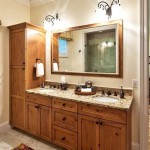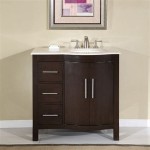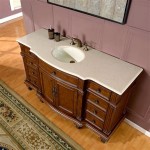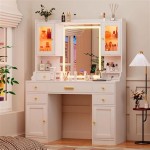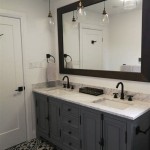The Appeal and Considerations of a 30-Inch Black Bathroom Vanity Without Top
The 30-inch black bathroom vanity without a top presents a popular choice for homeowners and interior designers aiming for a modern, sophisticated, or minimalist aesthetic in their bathrooms. The combination of the compact size and the striking black finish makes it a versatile option suitable for various bathroom sizes and styles. The absence of a countertop allows for customization and the selection of a material and style that perfectly complements the overall design scheme. This article will explore the key considerations, benefits, and potential drawbacks associated with choosing a 30-inch black bathroom vanity without a top.
The 30-inch width offers a practical solution for bathrooms with limited space. Smaller bathrooms, powder rooms, or en-suite bathrooms often benefit from the compact design of a 30-inch vanity, maximizing available floor space and ensuring ease of movement. This size is typically sufficient for a single sink and provides adequate storage for essential bathroom items. However, the dimensions might feel restrictive for larger bathrooms or households that require more counter space or storage capacity.
The color black imparts a sense of elegance and sophistication to any bathroom design. Black vanities contribute to a contemporary and modern look, and they can also be incorporated into transitional or even traditional styles, depending on the chosen hardware, countertop, and overall bathroom decor. The dark color can create a focal point in the room, anchoring the design and adding depth. The visual impact of a black vanity can be particularly striking when contrasted with lighter colored walls, flooring, and fixtures.
The decision to purchase a vanity without a top offers considerable flexibility in design. Homeowners can select a countertop material that meets their specific functional and aesthetic needs. Options range from natural stone like granite or marble to engineered materials like quartz or solid surface. Each material offers its own benefits in terms of durability, maintenance requirements, and visual appeal. Furthermore, choosing a separate top allows for the selection of a specific sink style, whether it be an undermount, vessel, or drop-in sink, further customizing the vanity's functionality and appearance.
Key Point 1: Space Optimization and Size Considerations
The primary advantage of a 30-inch vanity lies in its space-saving design. This size is ideal for small bathrooms, guest bathrooms, or powder rooms where maximizing usable floor space is a priority. When selecting a vanity size, it is crucial to measure the available space accurately, taking into account door swings, plumbing access, and comfortable movement within the room. A 30-inch vanity provides adequate storage for essential toiletries and cleaning supplies for a single user. However, for master bathrooms or households with multiple users, a larger vanity size might be more practical to accommodate greater storage needs and prevent countertop clutter.
Consider the overall layout of the bathroom when determining the appropriate vanity size. If the bathroom is narrow or has an awkward configuration, a 30-inch vanity can be strategically placed to optimize the flow of movement. In larger bathrooms, a 30-inch vanity can be used as a secondary vanity unit, supplementing a larger primary vanity to provide additional storage or separation of spaces. For example, in a master bathroom with two sinks, one could use a 60 inch vanity for two sinks with a 30 inch vanity on the side for personal hygiene supplies.
Another aspect to consider is the vanity's depth. While the width is 30 inches, the depth can vary depending on the design. A shallower vanity might be necessary in extremely tight spaces, while a deeper vanity offers more storage capacity. Evaluate the dimensions carefully to ensure that the vanity fits comfortably within the bathroom without obstructing walkways or feeling cramped.
Key Point 2: The Aesthetic Impact of Black Finish
The black finish of a vanity introduces a distinct aesthetic element to the bathroom. Black is a bold and versatile color that can be used to create a variety of design styles, from modern and minimalist to classic and traditional. The black color is a popular option to provide an accent and a statement to the entire bathroom. The contrast between the color of the walls and the black vanity provides a visual punch.
One of the key benefits of a black vanity is its ability to complement a wide range of color palettes. Black works well with both light and dark colors, allowing for flexibility in the choice of wall paint, flooring, and accessories. When paired with white or light-colored walls, a black vanity creates a striking contrast that enhances the sense of brightness and openness in the bathroom. When combined with darker colors, it can create a more dramatic and intimate atmosphere.
The choice of hardware also plays a crucial role in defining the aesthetic of a black vanity. Brass or gold hardware can add a touch of warmth and luxury, while chrome or stainless steel hardware contributes to a more modern and sleek look. Matte black hardware can create a cohesive and understated design. The finish of the hardware should be chosen to coordinate with other fixtures in the bathroom, such as faucets, showerheads, and light fixtures.
Furthermore, the finish of the black vanity itself can impact its overall appearance. A glossy black finish will reflect light and create a more dramatic effect, while a matte black finish will absorb light and convey a more understated and sophisticated look. The finish should be selected based on the desired level of visual impact and the overall design style of the bathroom.
Key Point 3: Customization Through Countertop Selection
The absence of a pre-installed countertop offers a significant advantage in terms of customization. Homeowners have the freedom to select a countertop material, color, and style that perfectly complements the vanity and the overall bathroom design. This allows for a personalized touch and the creation of a unique and cohesive space. Choosing the right countertop materials is key to the overall longevity and success of the bathroom.
Several countertop materials are commonly used for bathroom vanities, each with its own unique characteristics and benefits. Granite and marble are popular choices for their natural beauty and durability. Quartz countertops offer a similar aesthetic to natural stone but are more resistant to staining and scratching. Solid surface countertops are a more affordable option that is also non-porous and easy to maintain. Laminate countertops are the most budget-friendly choice but are less durable than other options. Wood countertops are also an option, but they need to be properly sealed and maintained to prevent water damage.
The color and pattern of the countertop should be carefully selected to complement the black finish of the vanity. White or light-colored countertops will create a striking contrast that enhances the visual impact of the vanity. Gray or beige countertops will offer a more subtle and understated look. Dark-colored countertops can create a more dramatic and cohesive design. The pattern of the countertop, such as veining or swirls, can also add visual interest and personality to the vanity.
The choice of sink also influences the countertop selection. Undermount sinks require a solid countertop material that can be cut to accommodate the sink opening. Vessel sinks sit on top of the countertop and require a countertop with a pre-drilled hole for the drain. Drop-in sinks are installed from above and require a countertop with a cutout to fit the sink rim. The sink style should be considered when choosing the countertop material and design.
Finally, the edge profile of the countertop can also contribute to the overall aesthetic of the vanity. Common edge profiles include square, bullnose, and ogee. The edge profile should be chosen based on the desired level of visual detail and the overall design style of the bathroom.
In summary, a 30-inch black bathroom vanity without a top is a versatile and stylish option for bathrooms of various sizes and styles. Its compact size makes it ideal for small spaces, while its black finish adds a touch of elegance and sophistication. The absence of a pre-installed countertop allows for customization and the selection of a material and style that perfectly complements the overall design scheme. By carefully considering the space constraints, aesthetic preferences, and functional requirements, homeowners can select a 30-inch black bathroom vanity without a top that meets their specific needs and creates a beautiful and functional bathroom space.

Style Selections Meera 30 In Black Bathroom Vanity Base Cabinet Without Top Me30p1 Mb At Com

30 Inch Vanities Black Bathroom Without Tops The Home

Adrinfly Modern Stylish 29 3 In Bath Vanity Cabinet Without Top 33 With Storage And Drawers For Perfect Organization Black 29bsa05 1055 The Home

Berkshire 30 Vanity No Top

Black Bathroom Vanities Without Tops At Com

Brookings 30 Inch Fully Assembled Urbane Bathroom Vanity ǀ Bath Today S Design House

Brookings 30 Inch Fully Assembled Urbane Bathroom Vanity ǀ Bath Today S Design House

Avanity Mason 30 In Black Bathroom Vanity Base Cabinet Without Top V30 Bkg At Com

30 Inch Vanities Black Bathroom Without Tops The Home

Modway Steamforge 30 In W X 18 D 39 5 H Bath Vanity Cabinet Without Top White Black Eei 6415 Whi Blk The Home
